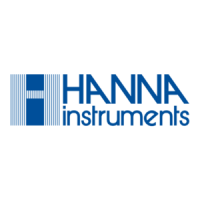19
CALIBRATION
8. CALIBRATION
Press Menu to enter the main setup menu, use the / keys to highlight Calibration and then
press Select.
8.1. pH PROBE CALIBRATION (HI829113)
All calibration data is stored on the probe, allowing probes to be connected to different meters without
recalibration.
It is recommended to calibrate the instrument frequently, especially if high accuracy is required.
More frequent calibrations may be required depending on the type of sample being tested, i.e. turbid
biologically active water samples will require more frequent cleanings and calibrations than cleaner
waters.
The probe should be recalibrated:
• Whenever the probe is replaced.
• At least once a week.
• After testing aggressive samples.
• After cleaning the sensor.
• If “Outside Cal Range” message blinks during measurement (the measurement is outside the
current calibration range).
• If enabled, when the “CAL DUE” calibration time out message is displayed.
pH CALIBRATION
From the Calibration menu, use the / keys to highlight pH and then press Select.
Calibrate pH allows the user to perform a new calibration using up to three buffers. When a three-
point calibration is performed the existing data is overwritten. A single or two-point calibration will
use existing calibration data, if available. Use the / keys to highlight Calibrate pH and then
press Select.
PREPARATION
Pour small quantities of the buffer solutions into clean beakers. If possible, use plastic beakers to
minimize any EMC interferences. For accurate calibration and to minimize cross-contamination, use
two beakers for each buffer solution: one for rinsing the electrode and one for calibration.

